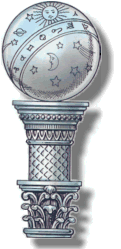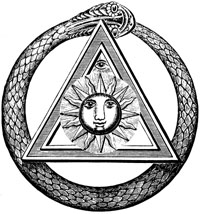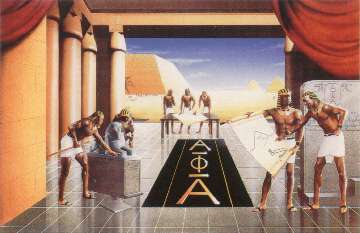I. The Meaning and the Significance of Landmarks
A first attempt to find the meaning of the term
landmark points out that
in the early Anglo Saxon,
German, or Scandinavian languages the noun “land” meant the same as in modern
English, although as a verb it meant “come to land,” a meaning reflected in our
custom of saying a man lands from a ship, etc. “Mark” is found in almost all
European languages and derives from the Latin margo, “edge” or “boundary”,
whence our margin, mark, and cognate terms. A “landmark” is some mark, line or
object to indicate a boundary. The landmarks of Masonry are those principles by
which the Craft is bounded, that is, marked off from all other societies and
associations and without which it would lose its identity.[1]

The word
landmark in architecture signifies an element, or a whole part of a building,
or sometimes a statue, or a decoration in the entrances to it that is of great
importance for the whole architectural plan. Sometimes the building as a whole
serves as a landmark for the geographical area. In all cases the landmark is a
cathedral or architectural structure with a distinct meaning and symbolism,
which makes the building or the geographical place totally discernable from any
other place or building. A similar practice has resulted in the allegorical use
of the word landmark in Masonic philosophy, marking a cathedral point in the
inner organisation and way of thinking in Masonry, without which it would be
impossible for a lodge to be characterized and seen as such. I consider the
second, architectural, significance of the term landmark
as more important than the linguistic one, the reasons for which
will be the object of further analysis in this article.
The most incontestable point is that the landmarks
embody the unalterable and inviolate rules of the Masonic organization, theory
and esoteric tradition as a set of sacred principles, which can never come
under review. This rule of inviolability is the last and crowning landmark in
the better-known enumeration, written by Albert Mackey[2],
according to which “the landmarks can never be changed”. In other words in
medieval terminology this may be expressed as “nolumus leges mutari”,
“let the laws abide”.

Some
authors[3]
have explained the legal usage of landmarks in freemasonic governance by
drawing a parallel between the landmarks and the English principles of common
law, or the unwritten British Constitution. The landmarks crown the hierarchy
of rules in the Masonic legal order of pyramidal structure. If legislation has
violated the landmarks, it becomes subject of Masonic judicial determination.
If a violation can be demonstrated; the violating rule becomes null and void,
with the legal effect that no regular Mason is bound to observe it any longer.
It may happen, of course, that the courts of different Sovereign Grand
Jurisdictions disagree as to whether a principle is a landmark, or as to
whether there has been violation of a commonly accepted landmark.
In that case the individual Mason is obliged to follow the interpretation of
his own Jurisdiction.[4]
Other authors[5]
focus on the biblical roots and symbolical significance of the landmarks. In
the Bible the landmarks are regarded as highly venerable and sacred. In
Deuteronomy 27:17 it is written “Cursed be he that removeth his neighbour’s
landmark” and in Proverbs 22:28 someone says “Remove not the ancient landmarks
which the fathers have set.”
The above mentioned biblical significance of the
landmarks is in accordance with another metaphor from the ages of Operative
Freemasonry, in which the Landmarks could be regarded as equivalent to the five
perfect points of Entrance and closely connected with the architectural
definition of term Landmark, as explained above. The Operatives had as their
principal aim to build the symbolic Temple of God, the Temple of Light as
Solomon and the ancient priests of all religious dogmas and mysteries did, by
building the Gothic Cathedrals according to the rules of divine Geometry and
Architecture. They realized from the synergy of various esoteric societies,
through the acceptance of Rosicrucian, Hermetic, Cabbalist, and Templar refugees
as new members in the Guilds, that the esoteric tradition was unique and
unalterable through the ages.

The points
of Entrance to the Temple of Light were allegorically written over the upper
parts of its doors as crowning scripts. In order to be admitted to the first
room of the Temple, the new member had to manifest his belief in these sacred
principles without asking for proof of these axioms. The belief
in God; the immortality of the souls; the Secrecy; the Ritual of Resurrection;
and the prerogatives of the High Priest, who was seen as the Priest-Sun in the
Circle of initiates, were the first five most ancient Portals-Landmarks of the
Divine Temple, in Egyptian religious thinking and in the Greek Delphic
Mysteries, as well as the Pythagoreans and the Platonic circles. Rightly Doron[6]
points out that the need felt by masons to trace unalterable, sacred Landmarks
throughout the ages supports the “Transition Theory”. The elements of “unalterable
usage” and of the “existence from time immemorial” as conditions
for the qualification of a general principle as a Landmark, theoretically
presuppose its “Transition”. For that reason the existence of the Masonic
Landmarks as such totally justifies, in my judgment, the archaic origin of
Freemasonry and its “Transition” through the ages.

II. The
Landmarks and the Old Charges
The landmarks must be discerned from the
Old Charges.[7] Under the
last term are meant all medieval texts of the pre-speculative Masonic history,
which described the rules of the inner organisation of the Guilds as well as
their beliefs and attitudes. Some Old Charges have been considered and
qualified as Masonic landmarks simultaneously, because they prove their incontestable
usage and validity from time immemorial and became very significant
for Masonic philosophy at a later time. The belief in the Supreme Being is such
a Landmark and an Old Charge at the same time. We find it in the Constitutions
of masons of Strasbourg[8],
dated from 1459, as a duty of mason to be a good Christian and also in the
Rules of the German Steinmetzen, literally “stone-measurers”, as a duty
to believe in God[9]. The
medieval masons used as a greeting the formal words “God greet ye, God guide
ye, God reward ye, ye honourable overmaster, warden and trusty fellows.” [10]
At that time many formal words and gestures manifested a belief in a Supreme
Being.
A second Old Charge, which has been transformed over
the passage of time and is the first Landmark listed by Albert Mackey, is the
usage of modes, or signs of recognition. The rituals of the German
Steinmetzen included, among other elements, the positioning of a brother’s body
and hands to provide a mode of recognition between the members and also as a
method of giving silent “bodily” messages of a symbolic and emblematic nature. [11]
A third Old Charge, which reflects much of the modern
Masonic philanthropic and moral philosophy, is expressed as “No fellow shall do
another’s work for money, but he shall do one piece for another, or do it for
him to his honour.”[12]
An unwritten Landmark was developed from this obligation of altruistic support
between the brothers of the medieval Guilds and is related to the humanistic
tradition of the Age of Enlightenment, which prescribed that:
“Freemasonry is based on a dogma of altruistic
and humanistic philosophy, based on the respect of human values and a
philanthropic moralistic dogma.”
III. The Various Enumerations of the Landmarks -
An Analysis of the most important
The lists of landmarks vary in number from author to
author. Albert Mackey presented 25 landmarks, but others reduced the list to 7
or even to 5 principal landmarks, which incorporate Mackey’s twenty other
landmarks as subdivisions. The principal landmarks refer either to the
organization of the lodge, or to the inner meanings and the ideological or
cathedral points of the craft that may be analysed as follows.
1. The
landmarks of an administrative nature can all be combined in one greater
category under the general rule: “The lodge as an institution must be
governed according to the ancient accepted rules and traditions
of the Craft, according to which a Grand Master ultimately is
responsible for the government of the fraternity. His prerogatives,
to make freemasons on sight, to grant dispensations for conferring degrees, to
establish “Lodges under dispensation” and to preside over every assembly of the
Craft, are inviolable. The equality between the brothers
is an unalterable principle.”
The prerogatives of the Grand Master reflect the
respect and position of supremacy held by the archaic High Priest in every
mystery circle and religious community in Antiquity. The High Priest possessed
exceptional rights because of his wisdom and the respect held for his position
as head of the Pyramid of Initiation. He could grant exceptions from the
recognized rules, when and whenever it was necessary. He symbolized the Sun;
which also is the symbolic rank of the Grand Master of a Grand Lodge nowadays.
Many authors define the Principle of Equality
between the Brothers as their right to participate on equal terms in the
Congregation of the lodge, as well as their right to be represented, their
right to visit other lodges, the principle that one Grand Lodge must not
intervene in the work and rules of another Grand Lodge and the right of every
Mason to appeal to Grand Lodge against the decisions of his lodge. All these
rights should be considered as derivatives of the Principle of Equality, which
is a subdivision of the Landmark relating to the administration of the Craft
under the established and ancient rules.
2. The
landmarks of ideological nature are the most significant and the most
controversial among the different Grand Lodges and their various ideological
lines upon to what freemasonry is and what its aims should be.
A. The first
landmark in this category should be the rule of secrecy of the Masonic
rituals, to which should be annexed the landmark of the modes of
recognition, usually seen as a separate landmark.

According
to all ancient rituals of initiation in the mysteries of the Temple of God the
new members had to follow a mystical path from the first room of the Temple to
its innermost room, the so called Adyton. The Architecture of the
ancient temples followed the divine plan of initiation, step-by-step, from room
to room, where the rooms were decorated and divided with special architectural
landmarks. Koldeway[13]compared
the organisation of interior space in the temples at Selinous with that of
Solomon’s temple, the ancient Egyptian temple, and the Christian basilican
church. In each of these a religious sequence is experienced as a journey or
progression that advances from the regular to the sacred, the way of
initiation. The Adyton signifies
that the inner room is “not to be entered”, thus symbolizing the rule of
secrecy from the first degree to the last or highest degree. The oracles of the
God Apollo in the temple of Delphi were pronounced from within the Adyton,
which was below the ground. Only the High Priest or the Council of High Priests
had the right to enter the Adyton, in the same way as only the higher
level of initiates in Masonry achieve a superior grade of knowledge. The
concept of Adyton expresses the condition that the degrees of initiation
were not freely accessible to everyone, but had to be achieved progressively.
The secrecy of the various grades secured the sacred knowledge from the profane
and was an incentive for the initiates to make progress along their pathways of
initiation.

In
addition the rule of secrecy was symbolically represented in the ancient
temples with the curtains that covered the statue of God, positioned in
the inner sacred room, in the Adyton of the Temple. The Old Testament
was protected and covered in the Tabernacle and was intended to be placed in
the Temple of God when it had been erected. We are told in Exodus 36:8 that the
Tabernacle was covered by curtains made of “fine twined linen”. Each of the men
who worked on the construction of the Tabernacle made ten curtains. When
assembled, they were raised over the Tabernacle to form a gable roof.[14]
The Egyptian Goddess Isis was covered with veils, in the same way as the secret
teachings of freemasonry and its degrees are protected with the veil of
allegory. All the paradigms refer to the inviolable status of the secret
divine knowledge, which could only be approached by and revealed to the
initiates, the priests and the elected ones who were able to remove the
veils of secrecy and allegory. The same rule has survived to the present day in
the Masonic Initiation, in which the upward advancement through the scale of
Masonic Degrees signifies that in each degree a metaphorical veil is removed so
that the mason progressively acquires the sacred knowledge.
The modes of recognition served as signals for
the close circle of initiates and were used in the Medieval Guilds to exclude
uninstructed persons, thus protecting the members of their archaic lodges from
the enemies of the Craft during the Dark Ages of the Inquisition.[15]
Albert Mackey considers as an administrative Landmark
“the necessity that every lodge when congregated should be
duly tiled.” This is the eleventh Landmark according to his
enumeration. I consider that it is an integral part of the Rule of Secrecy.
Mackey comments on his Landmark: “The necessity of this law arises from the esoteric
character of Freemasonry. As a secret institution, its portals must of course
be guarded from the intrusion of the profane, and such a law must therefore
always have been in force from the very beginning of the Order.” [16]
The office of Tiler therefore cannot be abolished in any attempt of innovation.
Having elucidated the archaic roots of the rule of
secrecy, it has become clear that the Landmark of Secrecy consists on the
following rule: “Freemasonic degrees, initiation and the administrative
proceedings of the Craft are secret. The freemasonic institution uses the
well-established rules of recognition. The office of Tiler ensures that the
profane are kept outside the entrances of the Lodge.”
B. The
second Landmark consolidates the belief in a Supreme Being and of the
immortality of souls as an unalterable and incontestable
requirement. Grand Lodges who tried to introduce Atheism as an acceptable
philosophical attitude in the Craft, by omitting this Landmark and the letter
G, definitely renounced being masons. It is the strongest form of irregularity,
because it destroys the inner esoteric meaning of the words of the rituals and
the purpose of the existence of Freemasonry.

The belief
in the immortality of souls and of a resurrection to a future life is a
subcategory of this landmark and not a separate one. Masonry in almost all of
its rituals uses biblical extracts to recount the message of a spiritual
rebirth and to confirm the belief in a future life after the “resurrection” of
the human soul and humankind, as taught in the higher Templar degrees. It
cannot be specified in any detail what type of future life will be found in the
symbolical hereafter of the Masonic rituals, without a detailed analysis of the
ancient Pythagorean and Platonic doctrines upon the immortality of the soul, in
which they elaborated upon the pre-existent traditions of the Egyptian and the
Mithraic Mysteries.

C. The Ritual of the third degree
preserves the cathedral character and integrity of the centuries of Masonic
history and constitutes the third ideological Masonic Landmark. The Hiramic
Legend constitutes the main part of this ritual. The story describes three
levels of a universal mythical drama, which is taken from the Bible. In the
first level the spiritual growth and creative talents of Master Hiram and Hiram
King of Tyre are presented, as it was manifested in the construction of the
King Solomon’s Temple. In the second level the treason and the murder of the
Master Hiram by the three traitors is described, revealing the destructive
force of jealousy. The third level is victorious end of the myth, in which
Master Hiram is reborn as a result of the divine manifestation in the human
soul. This victory is part of the eternal circle of regeneration or, according
to a more mystical explanation, to the divine plan for never ending
reincarnation that leads to the platonic sublimation of the souls. The three
steps analysed above are the essence of the Hiramic Legend of the third degree.
The
contestable Landmark of the division of masonry into three degrees cannot
be sustained. Historically an absolute rule of the division of masonry into
three degrees has never existed. Some Masonic Guilds and medieval
brotherhoods were incontestably organized in three degrees; the Entered Apprentices,
the Fellows and the Masters or in the German Steinmetzen system in
Lehrlingen, Gesellen and Meister[17].
However other Masonic groups, like many Operative Societies were incontestably
organized in seven mystical degrees, more elaborate in
their esoteric teachings.[18]
In France during the years from about 1730 to about 1780, under the
name Grand Temple of Lyon, the so-called group of Elus Coens operated under the
leadership of Pasqually. They recognized and used a system of seven
mystical degrees.[19] Therefore
it cannot be concluded that three degrees were the absolute and unique division
of the early Masonry, in a way that could be established as a landmark. The
element of “unalterable and unbreakable usage” is missing,
so that the landmark cannot come to life.
The three degrees or steps of initiation must be seen in
interaction and as an integral part of the landmark of
the third degree. They were established in all ancient mysteries and were
related to the eternal circle of three steps in human life: I birth, II
death and III resurrection of the soul. At the same time the third step
signifies the beginning of a new cycle. The Hiramic Legend of the Master
Mason’s degree reflects the same three steps of initiation. Pythagoras had
three Mystery Degrees for which a preparation of five years of abstinence and
silence was required.[20] Furthermore, these three stages of psychic
development through a series of degrees also appear under other ritualistic
allegories, as in the whole scale of the 33 degrees of the Scottish Rite. These
three stages are:
1)
Material stage: Innocence,
blindness at the beginning, repentance, light;
2)
Intellectual stage: sympathy,
justice, gratitude, veneration, knowledge of the divine rules of geometry,
psychical condition of harmony;
3)
Spiritual stage: rebirth, the
mystery of the death and of resurrection, faith and the rule of universal love.[21]
These Scottish Rite degrees offer different
explanations of the Hiramic Legend, frequently using many elements of the first
three steps of initiation to reveal more mystical meanings of them, according
to other systems of allegorical and mythical interpretation. It is a
progressive discovery of the veils of Masonic allegory.
As a conclusion the only existent Landmark should be
concretised as follows: “The ritual of the Third Degree in unalterable
and must be accomplished in three elementary psychological steps of initiation,
two of an introductory and preparatory nature and a third during which the rite
of rebirth must be performed.”

D. The foundation of a speculative science upon an
operative art is the fourth important ideological Masonic Landmark. The
speculative and operative elements constitute a fascinating duality in
the nature of the Masonic Institution. The Operative Art instructed through
the centuries by giving all required specifications and details of the ideal
materials with which the House of God, the spiritual Temple of Light, will be
erected. The Operative Art schedules in perfect Geometry, with symbolical words
and deeds. The Speculative Science follows as a theoretical companion, through
the catechisms, to analyze these symbolical words and deeds of
the Operative Art. In this way it contributes to the explanation of the
theosophical and esoteric allegories of the operative myths and rituals. Albert
Mackey comments in his Encyclopaedia of Freemasonry: “Hence, all the
comparatively modern rites of Freemasonry, however they may differ in other
respects, religiously preserve this temple history and these operative
elements, as the substratum of all their modifications of the Masonic system.”[22]
The ritualistic element should be added
to the Landmark as inviolable. The Masonic rituals find their origin partially
in the ancient Mithraic, Orfical, Apollonian and Dionysian mysteries, which
were played in theatrical form and partially in the sacred plays or
religious dramas that the Masonic Guilds presented periodically once, or twice
a year in public festivities in the medieval cities.[23]
The medieval masons played as mysteries and dramas the biblical stories that
they were carving in stone in the Gothic Cathedrals. This theatrical way of
transmitting sacred knowledge, using instinct and emotion rather than logic,
was adopted by the lodges and led to the modern Masonic rituals. This is why
the ritualistic element constitutes a third essential element in the nature of
Freemasonry. If a modern lodge tried to abolish the ritualistic character of
the Craft by transforming lodges into purely theoretical assemblies, in which
only lectures would be given without the element of acting or communal playing
in accordance with the known form of rituals, it would cease being a Masonic
body.
The Landmark could be modified according to my
proposal as follows: “In all Masonic degrees a speculative science can be
founded upon the operative art and coexist with it. The ritualistic character
of Freemasonry must remain inviolable.”
IV. Summary - the seven Landmarks
Having analyzed the archaic roots and the importance
of the Landmarks I now propose a list of seven Landmarks that, in my judgement,
should be regarded as “having existed from time immemorial” and therefore must
be seen as “unalterable” rules of the Craft.
1. Freemasonic degrees, initiation and the
administrative proceedings of the Craft are secret. The freemasonic institution
uses the well-established rules of recognition. The office of Tiler ensures
that the profane are kept outside the entrances of the Lodge.
2. The belief in a Supreme Being and the immortality of souls is an unalterable and incontestable theosophical
cornerstone of the Craft; therefore it cannot be abolished. A
Book of Divine Law must be open in the lodge when it is at work.
3. The ritual of the Third Degree in unalterable and
it must be accomplished in three elementary psychological steps of initiation,
two of an introductory and preparatory nature and a third during which the rite
of rebirth must be performed.
4. In all Masonic degrees a speculative science can be
founded upon the operative art and coexist with it. The ritualistic character
of Freemasonry must be inviolable.
5. The
lodge as an institution must be governed according to the ancient accepted
rules and traditions of the Craft, according
to which a Grand Master is ultimately responsible for the government of the
fraternity. His prerogatives to make freemasons at
sight, to grant dispensations for conferring degrees, to establish “Lodges
under dispensation” and to preside over every assembly of the Craft, are
inviolable. The equality between the brothers is an
unalterable principle.
6. Freemasonry is based on a dogma of altruistic and
humanistic philosophy founded on the respect of human rights and a
philanthropic moralistic dogma.
7. These rules cannot be changed.


 Make this Website Your Start Page
Make this Website Your Start Page
 Print this Page
Print this Page
 Send Masonic Greeting Card
Send Masonic Greeting Card








